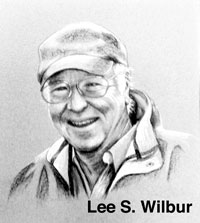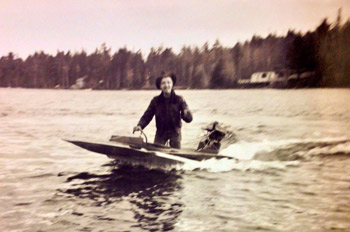First Boat

Throughout my career in boatbuilding there were more than several times when I was asked if I had learned the trade from my father, if he had started the boatyard, and on one occasion at a boat show, was questioned “if my Dad was there.” This particular individual said he’d met him several years ago and chatted with him at the shop. I was quite amused as my father was a “Medical Doctor,” didn’t really like the ocean, and as a hobby had a small workshop in the basement where I learned at a young age the fun of working with tools and wood. He was encouraging, relatively lenient with me, said no to using various power tools before I was ready, though I still carry scars because I really wasn’t ready but had no doubt pushed till he gave in.
Having more time now that retirement (only from boatbuilding) is the name of the game, I’ve reflected on various times of my life and how events have changed directions. Looking back, I cannot recall with any stretch of imagination if I ever thought, wanted, or considered the very rewarding life of boatbuilding. Yet, our family home was directly across the street from the eminent Ralph Stanley, “Dean Emeritus of Wooden Boatbuilding,” and I would marvel at the boats which came out of that small shed and be dragged to the water on wooden cradles. And, whenever I had the opportunity to play in the workshop, I hewed out “boats.” My second home, where I hung out many evenings after convincing the parents homework was complete or had none that night, was in the basement workshop of next-door neighbor and renowned bird carver, Wendell Gilley. There I carved boats as well as the occasional bird. Never a thought to be a builder.
By age 12 or 13, my field of boat endeavors had widened to the possibility of building a real boat and sent off to (I guess) “Glen L” in California for a set of plans to build the “Mini-Max” hydroplane. Neat boat which could be built from one piece of 4x8 marine plywood. Dad gave his blessing. Even asked a family friend, Raymond Young, boatbuilder at H. R. Hinckley’s, to give me a hand with the project.
Raymond was great. He showed me how to read the plans, where to buy the materials, then guided me along as the little Mini-Max began to take shape. Ray would go over the next step, I’d hope he would hang around while I made the cut or whatever, but he knew this was my project and left me to make my own mistakes.
Mini-Max was nearing completion, the rounded bow had been glued and clinch nailed, when Raymond allowed we’d probably better lay on some fiberglass around that bow joint just to make sure she wouldn’t leak. My guess he’d taken a hard look at my less than professional glue and clinch job and realized this would be a weak point. Now, I’d been building the boat on a newly linoleum tiled basement floor. Something my dear mother had been wanting ever since we moved into the house in 1946. In kid fashion, I’d tried to keep newspapers down while I worked, but glue had found its way under and around, a dropped tool or two had taken their toll and said linoleum in the work area had lost most of its gloss. Along comes the fiberglass and “RESIN.” Raymond, working in a “boatyard,” was used to the odor and drips on the floor. The Wilbur household enclosing Dad-the-Doctor’s office and the newly tiled basement floor had no clue what was to happen.
Home right after school, having thought of nothing else but getting in that basement and fiberglassing the bow, I went right to work. The Mini-Max would soon be complete and I could paint, mount hardware, and within a month—launch! Spring would arrive, then summer. I’d be the talk of the lake.
I mixed the resin with hardener and brushed some on, started laying the precut glass, and brushed some more resin. Aroma of resin made my eyes water. Wasn’t but a few minutes when down over the stairs came father with a concerned look, to say the least, right in the middle of his office hours.
“What is going on?” he says in a rather elevated tone of voice. “I’ve got a room full of patients upstairs and they’re all complaining. You’ve got to stop. AIR THIS PLACE OUT!!”
“Uh-Oh.” I didn’t dare to stop for long so I hurriedly opened the windows and door. But, by then the resin had started to cure. Glass was half resined. I panicked. Resin had slopped on the carefully, or not, newspapered floor, and was sticking to anything with a possibility, including but not limited to my sneakers. And, I’d mixed all the resin. Whole house reeked in curing resin fumes. Mother came home. She called downstairs, “Is everything okay?” It wasn’t. And worst of all, uncured resin had softened the linoleum, cured resin had glued the newspapers to the floor. I’d tracked dust and sawdust over a goodly area from the resin on my sneakers. An ungodly mess. Tried cleaning with acetone and that just made matters worse. Softened the linoleum as well. Finally took off the sneakers and went upstairs. Would being a fiberglass boatbuilder ever come up on anyone’s radar after this?

Lee Wilbur with his first boat, sometimes called hydroplanes after their ability to nearly fly over the water. They were a kind of motorized inverted frisbee. Lee Wilbur photo
Mini-Max was finally finished. Mess had somehow been resolved, though floor would suffer life-long scars. Mother and Dad had gone off to Virginia for the annual return to Mother’s relatives. Somehow they’d forgotten to mention I should wait until their return to launch son’s creation. So, I somehow convinced my two Explorer Scoutmasters, one, Charley Reynolds who had a 10hp Mercury motor, to loan me the motor and take the boat to Long Pond for a trial run.
Cold, overcast, May day. Launched it. Gingerly balanced the motor in place. Tightened it on, stepped in, pulled the cord and within minutes was roaring down the lake and out of sight.
“Wow,” it ran. It more than ran. It was fast!!
‘Course, the scoutmasters weren’t exactly thrilled I’d gone out of sight, nor were the folks when they got back home and found out about it; but I’ve always suspected that Dad the Doctor had his share of spirit as a young man because after the initial “You did what(s),” the household soon returned to normal. I used the Mini-Max for a few years until selling to a schoolmate who mentioned it had a tendency to sink when left unattended for a few hours. Fifteen years later we moved a 36-foot Newman hull into a newly purchased barn and I took up boatbuilding in earnest.
I’ve had some fun over the last few years with Balsamic vinegar bastings and reductions. This makes for a good excuse when there’s a foot of snow over the grill.
• R E C I P E •
2 T. whole black peppercorns
4 thick boneless ribeye steaks
1 T. vegetable oil
2 T. unsalted butter
Half-cup balsamic vinegar
Coarsely grind peppercorns, then pat dry steaks on both sides with the pepper, pressing into the steaks. Season lightly with salt. Heat the oil and 1 Tablespoon butter in a heavy fry pan until hot but not smoking. Reduce heat to medium and cook steaks 2 at a time four min. each side for medium-rare. Transfer to a warm platter. Add vinegar to pan and deglaze by boiling over high heat, scraping up the cooked bits. Simmer until reduced by one-half. Whisk in remaining butter. Check for salt seasoning as desired and drizzle over steaks. Enjoy by a warm fire.
Fair Winds and Good Roads
– Lee Wilbur
